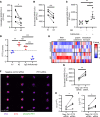Interferon-dependent signaling is critical for viral clearance in airway neutrophils
- PMID: 37071484
- PMCID: PMC10322684
- DOI: 10.1172/jci.insight.167042
Interferon-dependent signaling is critical for viral clearance in airway neutrophils
Abstract
Neutrophilic inflammation characterizes several respiratory viral infections, including COVID-19-related acute respiratory distress syndrome, although its contribution to disease pathogenesis remains poorly understood. Blood and airway immune cells from 52 patients with severe COVID-19 were phenotyped by flow cytometry. Samples and clinical data were collected at 2 separate time points to assess changes during ICU stay. Blockade of type I interferon and interferon-induced protein with tetratricopeptide repeats 3 (IFIT3) signaling was performed in vitro to determine their contribution to viral clearance in A2 neutrophils. We identified 2 neutrophil subpopulations (A1 and A2) in the airway compartment, where loss of the A2 subset correlated with increased viral burden and reduced 30-day survival. A2 neutrophils exhibited a discrete antiviral response with an increased interferon signature. Blockade of type I interferon attenuated viral clearance in A2 neutrophils and downregulated IFIT3 and key catabolic genes, demonstrating direct antiviral neutrophil function. Knockdown of IFIT3 in A2 neutrophils led to loss of IRF3 phosphorylation, with consequent reduced viral catabolism, providing the first discrete mechanism to our knowledge of type I interferon signaling in neutrophils. The identification of this neutrophil phenotype and its association with severe COVID-19 outcomes emphasizes its likely importance in other respiratory viral infections and potential for new therapeutic approaches in viral illness.
Keywords: Cellular immune response; Immunology; Innate immunity; Neutrophils.
Figures




Update of
-
Type I interferon-dependent IFIT3 signaling is critical for viral clearance in airway neutrophils.Res Sq [Preprint]. 2023 Mar 21:rs.3.rs-1812836. doi: 10.21203/rs.3.rs-1812836/v1. Res Sq. 2023. Update in: JCI Insight. 2023 May 22;8(10):e167042. doi: 10.1172/jci.insight.167042. PMID: 36993474 Free PMC article. Updated. Preprint.
References
-
- GBD 2016 Lower Respiratory Infections Collaborators Estimates of the global, regional, and national morbidity, mortality, and aetiologies of lower respiratory infections in 195 countries, 1990-2016: a systematic analysis for the Global Burden of Disease Study 2016. Lancet Infect Dis. 2018;18(11):1191–1210. doi: 10.1016/S1473-3099(18)30310-4. - DOI - PMC - PubMed
Publication types
MeSH terms
Substances
Grants and funding
LinkOut - more resources
Full Text Sources
Medical
Molecular Biology Databases

